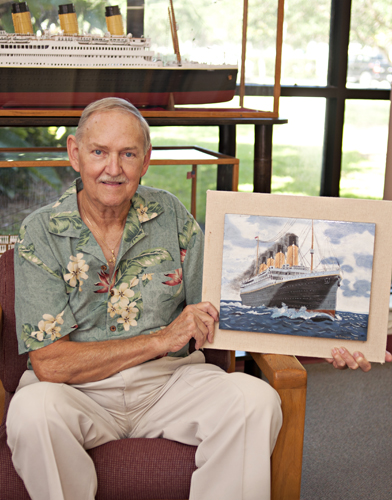
Prominently displayed in the North County Library, secure in glass cases and resting on deep red velvet, are two amazingly detailed replicas, the doomed Titanic and the paddlewheeler, City of New Orleans. Both were created by Sebastian artist Bill Conover, who recently donated them to the library.
These are not the typical model ships that come in a handy kit. These are entirely hand-crafted and faithfully reproduced in each tiny detail, the work of an artist who discovered his creative gifts almost accidentally.
A New Jersey native, Conover lived near Atlantic City and worked there as a policeman. In 1979, after several defeats, casino gambling was finally voted in by referendum, and the town changed. Troubled as he watched respect and camaraderie begin to disappear, Conover and his wife, Karen, decided to move.
They first chose Cape Cod, where they’d often vacationed, settling into a little house in Hyannis, and Conover purchased a sleek 55-foot Chris Craft, all mahogany and teak. “I’ve had a boat since I was 17, from rowboats to cabin cruisers,” Conover says.
The Cape draws many visitors who bring their yachts in the summer and leave for Florida’s warmer climes come September. Conover became acquainted with such a yachtsman, who observed his boating skills and suggested he get a captain’s license. Conover took the suggestion, obtained his license through the Coast Guard course in Boston, and was promptly hired by his friend to sail his yacht from the Cape to Florida and back each year.
For the next seven years, while Karen remained at her job in Cape Cod, Conover sailed down the coast in September and lived aboard the boat until spring, when he sailed back to Massachusetts. He chartered the yacht all summer around Nantucket and Martha’s Vineyard. The couple sold their house and lived aboard the Chris Craft in the Hyannis Marina for a couple of years.
Karen likes to tell of the time when there was a tap on the boat window. “It was Ted Kennedy,” she said with delight. “We’d see him a lot up there. He was a really good sailor, and he just wanted to tell us we ‘had the right idea,’ living on our boat.”
Eventually though, Karen had had enough cold weather and, in 1986, they left New England and journeyed to Ft. Lauderdale. As south Florida became more and more hectic and crowded, the Conovers headed north, landed in Palm Beach for a while and then, about three years ago, moved to Sebastian.
Married 40 years come October, they are now retired, he from his last career, as a carpenter for the Sun Sentinel, and she as a critical care nurse. They are happily settled in Sebastian, and consider it a great, “best kept secret” place to live. In their wonderfully eclectic living room, with five fluffy, friendly little dogs bouncing about, Conover tells the story of how the boat replicas came to be.
It was in Palm Beach that Conover’s artistic gifts became to emerge. “I have had a lifelong fascination with the Titanic,” he said. From a stack of several coffee table books, filled with stories, photos, statistics on every aspect of the doomed vessel, he gently lifted an old volume, a first edition, printed shortly after the 1912 disaster, the pages brittle and yellowed: “The Sinking of the Titanic and Great Sea Disasters.”
The faded black-and-white photographs of the proud, beautiful ship as it started its journey into history, the passengers smiling and waving from the deck, held an echo of foreboding.
Conover’s uncle was a carpenter and had taught his young nephew a great deal about the craft. As a policeman, Conover had supplemented his income doing various woodworking jobs. So he made a small workshop in the Ft. Lauderdale house, and set upon a creative journey that would last more than a year, translating the 900-foot-long original into a 5-foot-long replica.
“Everything is hand-made,” he says. Most of the wood is basswood. The lifeboats are hand-carved, faithful to the originals down to the unbelievably tiny White Star Line insignias on each. There are the tiny whistles, precisely placed in front of the stacks. Grinning, Conover pointed to the black and gold, oval smokestacks and disclosed, “The stacks are empty toilet paper rolls.”
The graceful riverboat, the City of New Orleans, was created shortly after Hurricane Katrina, to commemorate the suffering of the city and its people. It is, Conover explains, a faithful replica of the 300-foot-long paddle-wheelers that plied the Mississippi in the 1860s, as common as today’s taxis, carrying King Cotton to ports along the river and entertainment to small towns along the route – the famous showboats.
This replica, too, is astonishing in its beauty and faithful attention to detail, including the dining room with intricate French doors in the back. The deck is made of rich, polished, basswood planks. One of the most intricate details is the paddlewheel itself, cut from basswood with a tiny saw. It actually turns, and took Conover eight hours to complete.
A visitor to the library could stand gazing at the display time after time and always discover some new, delightful detail.
Another surprising aspect of Conover’s artistic gifts is disclosed as he rises, remembering something else he wants to share. He returns with two paintings – the Titanic and the City of New Orleans – beautifully done, with the same attention to detail apparent in the wooden replicas.
“I’d like to make a half model of the Titanic – and create all those beautiful interiors,” he sighs. “And It would be great to work in a film studio, making miniatures for the movies.” Creativity, he finds, just cannot be denied.



